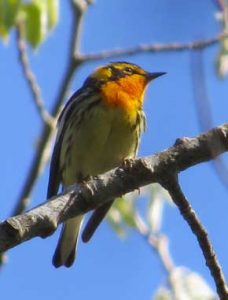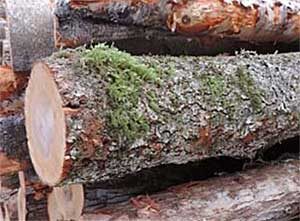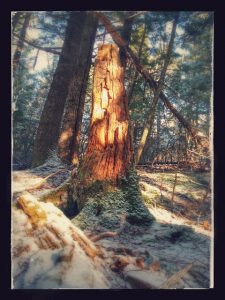As well as in op-eds and letters to the editor, more voices expressing concern about the state of Nova Scotia forests or simply a love of the Acadian forest are appearing in the social media. A few that I have come across recently are highlighted below.

Blackburnian Warbler photographed by Angela Granchelli
Of wood and warblers: musings on my upcoming 3rd spring migration season as a birder in Nova Scotia
Angela Granchelli writes her blog Atlantic Canada Birding as an “independent travelling sales representative with a large geographical area [who finds] birding a great way to unwind after a day of sales calls”.
She was inspired to write about wood warblers after attending Donna Crossland’s presentation to the Nova Scotia Bird Society on March 23. She compiled a list of the 22 wood warblers that breed in Nova Scotia and their preferred vegetation; she also lists “vagrant” visitors.
…as I reflect on my last two years in birding I am reminded that you have to do a bit of work to find some of the most prized wood-warblers…I remember looking up so high in the trees to spot the singing Blackburnian Warbler in Mount Uniacke Estates park and realizing this now scarce habitat explains why they are not always easy to find in Nova Scotia.
The Carbon Cycle, Mosses and our Forests
Anne Mills of the Nova Scotia Wild Flora Society wrote this piece as a contribution to the efforts of the Nova Scotia Healthy Forest Coalition.

Neckera pennata, a moss found on older standing hardwoods in moist woods, here on recently cut red maple. Photo by Anne Mills
Anne is one of the handfull of people in Nova Scotia who really “know their mosses”, a pursuit she took up anew in her retirement years. In this two-page essay (with an additional two pages of references and photos), she describes how soils are formed and the important role of mosses in carbon storage as well as their other benefits such as reducing soil runoff, filtering toxins from the air and land and providing a nursery for the germination of some seeds.
She comments on the drastic effects of clearcutting on mosses and mycorrhizal fungi. Photos of recent clearcuts taken off and along highway 103 between Mahone Bay and Chester Basin on March 18, 2017 illustrate her observation that
as I drive the highways across the province all I see are clearcuts and the scene from the air is even more bleak. Truckloads of logs roar by going where? And more and more new logging roads are being cut into the forests. Recent cutting along one of the 100 series highways showed a steep slope down to a waterway logged over.
It is time, says Anne, to change the forestry practices in Nova Scotia to maintain a healthy ecosystem.
Finally, Rediscovering My Acadian Forest is written by one of those non-traditional woodlot owners who it seems are being sought out to ‘participate in the forest economy’.
“My principle reason for setting up this blog is to help me consolidate my thoughts as I rediscover my Acadian Forest” writes the author, Tom Rogers. His first post was on Dec 27, 2017, and there have already been 21 posts in 2017, beginning with his First Complete Cruise.
“I knew we had a lot of bigger trees, but didn’t appreciate the quantity. And the diversity was a pleasant surprise — Hemlock, White Pine and Maple were the predominates but we have a strong representation of all the typical hardwoods and softwoods.”
It’s an enticing, ongoing story in which he gets to know his forest and consider options for managing it, all well illustrated with photos. He is informed by direct observations, reading and participating in workshops

“An old hemlock or red spruce slowly returning to the earth” Tom Rogers photo
I suspect that the author has become infected with biophilia:
About 40 acres in our forest are difficult to get to — there isn’t a proper road and there are several wet spots that inhibit motorized access.
So its been left to grow on its own … big hemlocks, towering white pine and red spruce along with majestic yellow birch, maple, oak and beech. Plus logs in various stages of decay and a lush under-growth of lichens, mosses and ferns.
Its a magical spot.
Thanks for sharing it with us, Tom.
UPDATE Apr 5, 2017: Tom writes about balance in his April 5 blog, looking at three elements: The Users, What you Give and What you Get
